I first rode the Live Hail at a Liv event in Sedona in November of last year. There I found myself riding in completely unfamiliar territory (dry, dusty and rocky) without hesitation. I came back feeling like I’d conquered a whole bunch of stuff I didn’t realise I could, and thinking that perhaps there was something to said about ‘women’s specific geometry’ after all.

Roll forward a few months to the chilly darkness of January 2017 and this Hail Advanced 1 landed for a spot of testing in conditions which could hardly be more different to those I experienced in Sedona. This bike is a step down from the Advanced 0 that I had ridden in Sedona (and which is not on sale in the UK), so no SRAM Eagle or Rockshox Lyrik, but it does have the same carbon frame with the ALUXX SL rear triangle. I was keen to see how it would fare on my steep local trails, as the Sedona trails had lacked extended periods of climbing and descending. Oh, and that other key UK mountain biking ingredient: mud.
The Bike
Designed from scratch rather than tweaking the existing Reign, the Hail combines the latest components with geometry designed to specifically work with the strengths of a woman’s body. Being designed to be fun to ride up as well as down has contributed to the Hail having a 1° steeper head angle compare to the Giant Reign, to ensure the bike is controlled and stable on rocky climbs, and doesn’t wander. Along with a short-ish stem, the front end of the Hail has been designed to make it easier for women to pop up the front wheel.
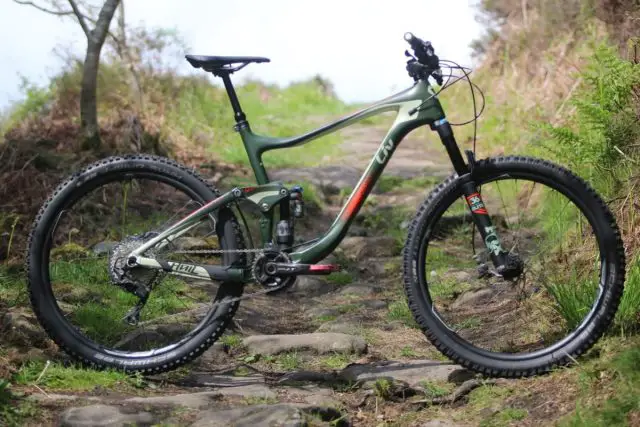
The Hail Advanced 1 comes in a distinctly non girly green colour scheme, and it’s been much admired on the trails. I’ve been testing the large, the same size as I rode in Sedona, which I have since discovered is not going to be available in the UK. At 176cm tall I’m right at the top of the recommended height for a medium size (164-176cm), and well into the height range for the large (170-184cm). Lindsey Richter, Liv ambassador and mountain bike skills coach, is the same height as me and dropped down to a medium after trying out a large. This is no shrinked and pinked machine, so unless you are well over 176cm I think you are unlikely to feel the absence of a large in the UK range, and I suspect I would have been comfortable on a medium. Indeed, given that I have to insert the dropper almost as far as it will go, I’m not sure that anyone smaller than 176cm is going to fit a large anyway. Number crunch time: the large has a reach of 450mm, and a standover height of 795mm, while the medium has a reach of 439mm and standover height of 755mm.
The Fox 36 Talas fork gives you the option to drop from 160mm travel to 130mm for technical climbs, plus a compression dial which effectively acts as a lockout. The Fox Float X2 Performance Elite with 2-position Lever gives you firm and soft options for climbing and descending.
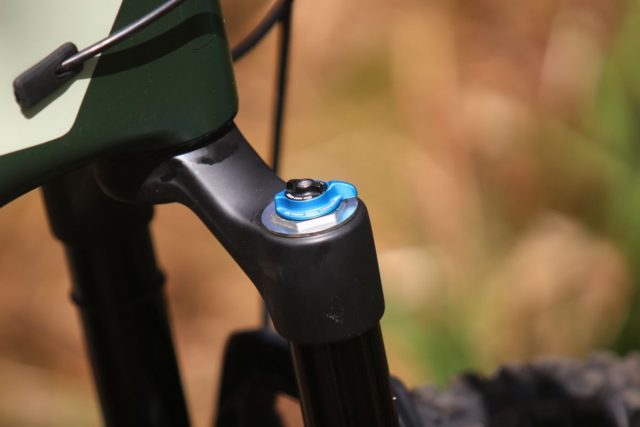
Rear suspension comes from an updated dual link Maestro suspension system with a new and improved Trunnion mount. The new Trunnion mount is made of a specially layered carbon composite that Liv claims makes the mount 50% lighter and 50% stronger than could be achieved in alloy. This mount is not unique to the Liv bikes and is fitted to some of the new Giant bikes for 2017, including the new Giant Trance and Giant Anthem models. It’s also featured on the alloy models of the Hail. This new mount allows the linkage to be joined to the shock at the side of the body rather than the top, which means that a longer shock can be fitted into the same space on the bike.
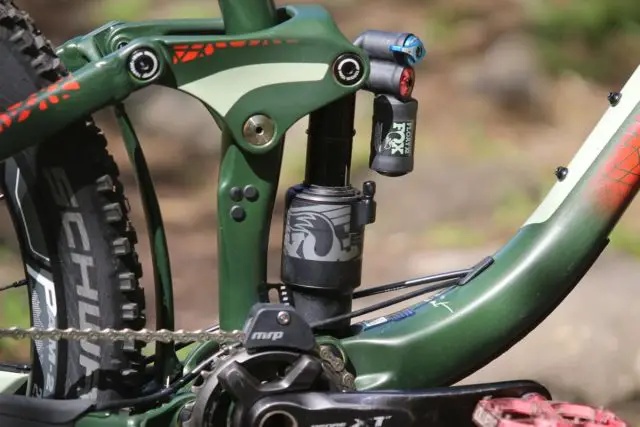
Along with the shock’s larger air volume, the Hail’s rear shock requires lower operating pressures to support the rider. In addition, the lighter Trunnion mount reduces the weight higher up the frame, meaning the weight is lower on the bike, reducing the centre of gravity. By keeping the centre of gravity low, Liv has been able to have a relatively high bottom bracket compared to what you’d expect from a 160mm bike, allowing riders to pedal over uneven ground with less risk of pedal strikes.
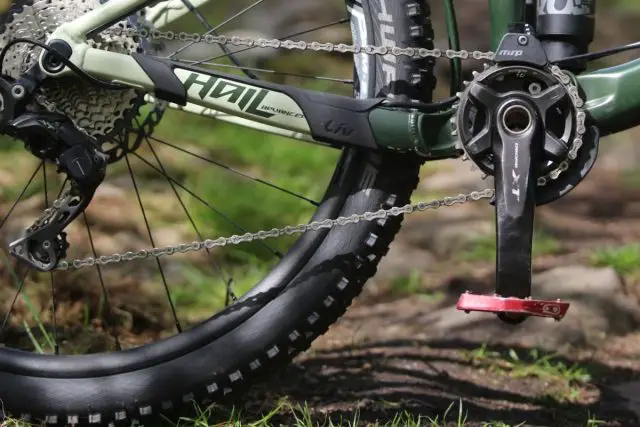
Built with a mix of Shimano XT and Deore components, the drive train has a 30T chain ring and 11-42T cassette on the rear. Compare this to another women’s enduro bike in the market – the Specialized Rhyme – which has 10-42T out back and a 28T chainring up front, and the Hail Advanced 1 offers more potential for flat and descending speed, but for those who prefer to sit and spin there’s not quite such an easy time on the ascents.
The Ride
As I’ve said, while the large I’ve been testing feels fine, it is a big bike with plenty of reach. Tons and tons of reach – the large has 450mm reach, whereas the much shorter Specialized Rhyme I tested previously offered 413mm reach in a medium…less that you’ll get from a Hail in small (415mm). Combine that reach with the high bottom bracket, and you can feel quite perched, especially if you’re not 100% confident about clearing the trail ahead. It’s a long way down to get a foot down (not that that changes between sizes), and I found that on my slippery winter UK trails this took a bit of getting used to. In fact, on some climbs I found myself having to use the dropper post to be able to get set off after a stop for a gate or obstacle. Over time I’ve got used to this, and I can get going again more easily, as the more I’ve ridden the Hail the more I’ve come to believe that the bike (and I) can get over whatever lies ahead on the trail.
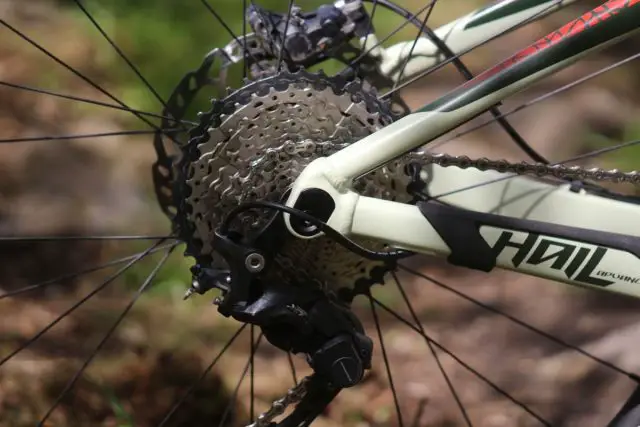
And therein lies the success of the Hail: it works. Time and time again I’ve found myself looking at a steep trail feature wondering whether I should be attempting it, and time and time again I’ve found myself at the bottom and past it before I’ve really finished thinking about being scared. If you point the bike and weight the bike, it will take you down safely. And there does seem to be something about the geometry that has me weighting the bike correctly – it encourages me to keep my body forward and stay in control, rather than hanging off the back. Given that it’s not as slack as some enduro bikes, I had expected to feel like I might push things too far and go over the bars on my steep local descents, but that hasn’t happened. Any topples have been sideways, generally as a result of my head giving in to my fears and grabbing brake at the last moment. If you keep the faith, progress generally continues.
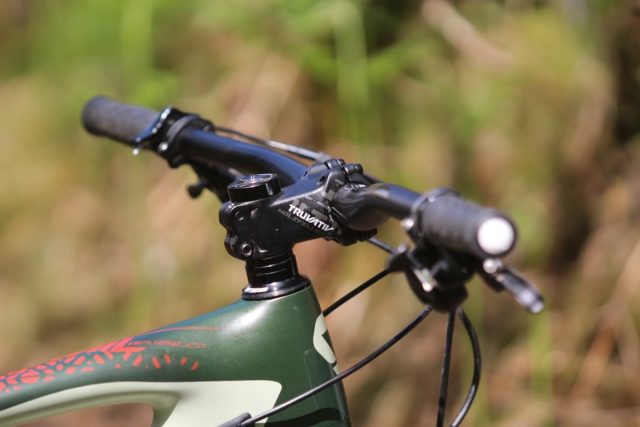
The same goes for pedalling upwards. Yes, it’s a long way down if you try and put a foot down while still in the saddle, but on the whole if you keep turning the pedals you’ll keep going forward – and the high bottom bracket does mean that there’s plenty of room to keep turning without catching the ground. There’s a local rocky slabby thrutchy climb – one that repeatedly grabs at any momentum you might manage to get – that I have only ever cleaned on the Hail. Not even an e-MTB has delivered the perfect run on this climb, but the Hail had me pedalling up and over each step up without forcing my weight into positions that lost traction.

That’s not to say it’s perfect. The contact points are, for me, a particular let down – the saddle doesn’t suit my behind, and the grips leave me with tired and blistered hands. Both aspects can be something of a personal choice, but these grips have been some of the few where I’ve absolutely had to change them, rather than just being out of preference. Contact points are easily changed, however and I’ll be addressing this in the final phase of my test. I’ve also had some concerns about the paintwork – for a bike that hasn’t been raced (yet) or massively crashed (fingers crossed), the paint is a little more chipped than I’d like. It’s not just rock strikes that are the culprit – the paint has flaked off around the pivot point too.
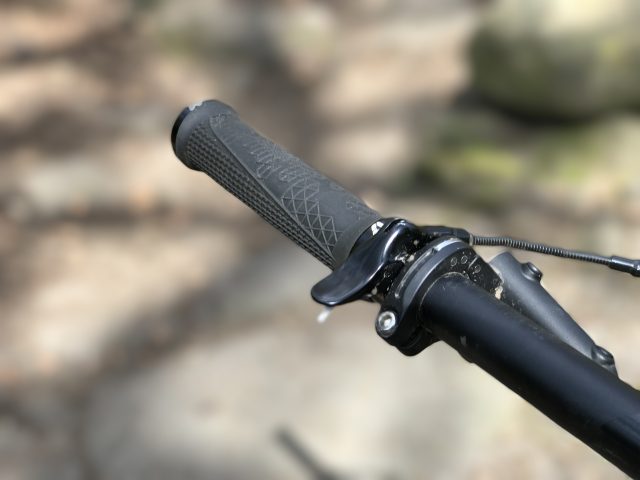
The dropper post has – in common with other Giant Contact SL posts we’ve experienced (such as that found on the Giant Trance Wil reviewed recently) – quickly become sticky. The remote isn’t particularly thumb friendly, especially in the wet, and requires a fair amount of oomph to get your saddle down and out the way. I’d prefer something much more tap-and-go for when you encounter trail features at short notice. All things considered, I think a medium frame with a longer dropper would probably give me a more nimble ride that kept my saddle right out of the way – I don’t have room for a longer dropper on the large.
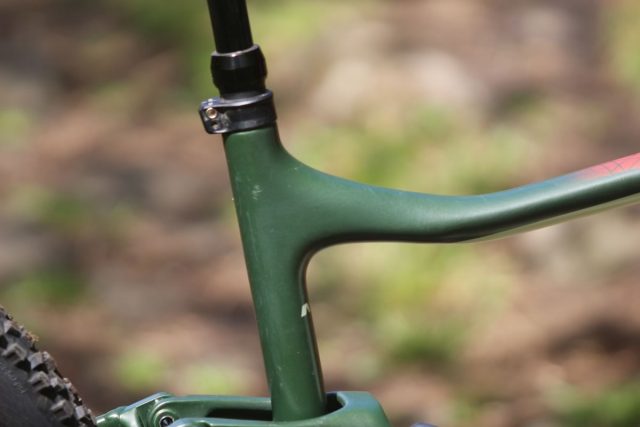
I think riding a slightly smaller frame would also give me that bit more standover height for situations where things don’t go to plan. While my large doesn’t feel too big while riding it, I have felt a little nervous of really slippery descents, where the foot down/BB height/frame collision/standover height mix becomes rather relevant – sometime in an unpleasantly intimate and painful way. Mud clearance has been no problem – although getting in and about the Maestro suspension for cleaning purposes is not particularly fun. The UK weather doesn’t seem to have adversely affected any part of the bike, except the dropper post, and having set the bike up tubeless I’ve not felt the need to swap tyres – I just alter the pressure according to conditions.

The suspension has been a bit of a challenge to set up, and I think I do prefer the buttery feel of the Rockshox Lyrik on the Advanced 0 to the Fox 36 on this model. It’s taken a fair amount of fiddling to get the balance of small bump shock absorption against it all feeling too soft, and I don’t think I’m quite there yet.
I’m not convinced that the Talas offers a great deal of benefit, as to engage the fork at 130mm takes a stop and a fair amount of push down – it’s not a click and go affair. This means that unless I know I’ve got a long technical climb coming and I’ve stopped to shorten the travel, I don’t get the benefit of it. Instead I’m more inclined to just keep pedalling with the compression set to firm, rather than stop and fiddle. This is particularly the case on new trails, where I don’t know whether a climb will be long enough or steep to be worth the time spent engaging the 130mm mode. If you do happen to stop and engage it, it does however give you a discernable benefit on really steep climbs of around 20%, where you’ll notice you front wheel sticking to the ground a lot better.
A side effect of having the Talas fork means that it doesn’t work with SRAM’s ShockWiz suspension tool – given the amount of tweaking I’ve been doing trying to get the set up to feel just right, the ability to use a ShockWiz would have been welcome. You can however use one on the rear shock, so in the coming weeks I’m going to continue tweaking the fork and hook the shock up to a ShockWiz, hopefully leading to that perfect tune.
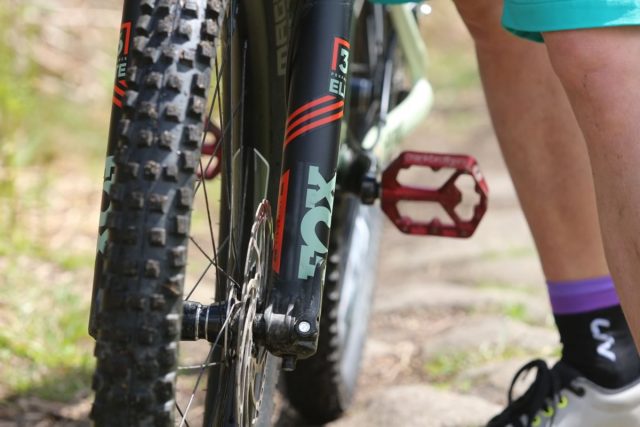
Despite feeling that I’ve not yet quite tuned the bike to its full potential, it has still been a heap of fun to ride. The more I ride it and try new trails, the more I’ve grown in confidence. I’m not really a ‘go fast and hard’ rider, instead preferring to get my mild peril experiences while picking my way through technical lines at slower speeds. But the Hail has me in a position where it gobbles up anything I point it at, peril free. Maybe it’s time to liven things up and venture into the world of speed. After all, this is what is was designed for.
Three things we’d change:
- The contact points: saddle and grips.
- A different dropper post that lasts in the slop and has a more ergonomic actuator. Ideally I’d like more room for a longer dropper.
- The fork – I’m not convinced that the Talas dual position option is useful.
Three things we like:
- Feeling super confident to try new things.
- It doesn’t look like a women’s bike.
- It puts you in a great position on the bike.
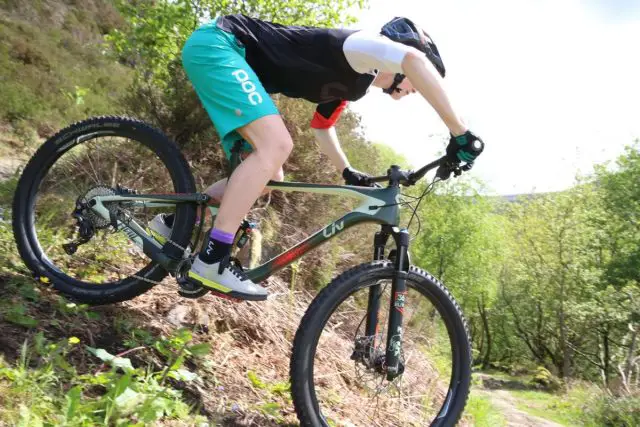
Overall
And so we enter the final phase of my long term test. I’m going to swap those contact points for some that suit my body and riding style. I’m going to get that seat post lubed up and working smoothly again. And then I’m going to don a full face helmet and take this bike where it deserves to be ridden: at my first enduro race. Let’s see if the ‘built to come alive at high speeds’ marketing lives up to its promise.
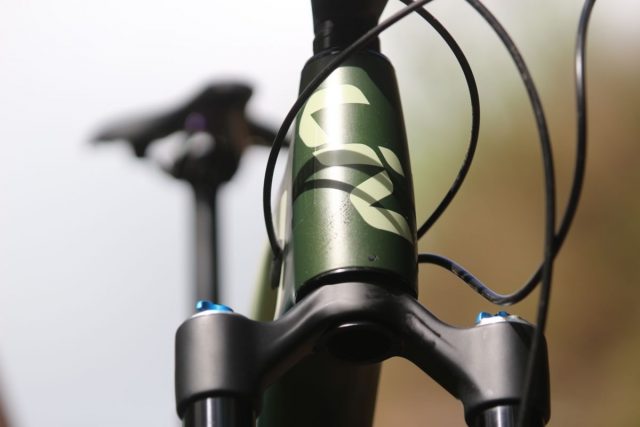
2017 Liv Hail Advanced 1 Specifications
Frame // Advanced-Grade Composite / ALUXX SL Rear, 160mm Maestro Suspension w/ Advanced Forged Composite Upper Rocker
Fork // Fox 36 Float Performance Elite, Dual Position 130-160mm Travel, FIT4 Damper, LSC Adjust, Boost 15x110mm, Tapered
Shock // Fox Float X2 Performance Elite with 2-position Lever, Trunnion Mount
Hubs // [F] Giant Tracker Boost 15×110, Sealed Bearing [R] Tracker Boost 12×148, Sealed Bearing
Rims // Giant P-AM2 Boost Wheelset
Tyres // Schwalbe Magic Mary 27.5×2.35″ Snakeskin, TL Easy, Trail Star [R] Schwalbe Hans Dampf 27.5×2.35″ Snakeskin, TL Easy, Pace Star
Chainset // Shimano Deore XT, 30 w/ MRP AMG V2 Guide (AL Backplate)
Front Mech // n/a
Rear Mech // Shimano Deore XT
Shifters // Shimano SLX 11 speed
Cassette // Shimano SLX 11×42
Brakes // Shimano SLX hydraulic disc brakes, 200/180mm rotors
Stem // Truvativ Holzfeller
Bars // Giant Contact SL DH, 800mm
Grips // Liv Lock-on
Seatpost // Giant Contact SL Switch-R Trail Dropper Post
Saddle // Liv Contact SL , Upright
Size Tested // Large
Sizes available // X-Small, Small, Medium,
Weight // 13.69kg
Review Info
| Brand: | Liv |
| Product: | Hail Advanced 1 |
| From: | Liv, liv-cycling.com |
| Price: | £3,899 |
| Tested: | by Hannah for 4 months |


You must be logged in to post a comment.